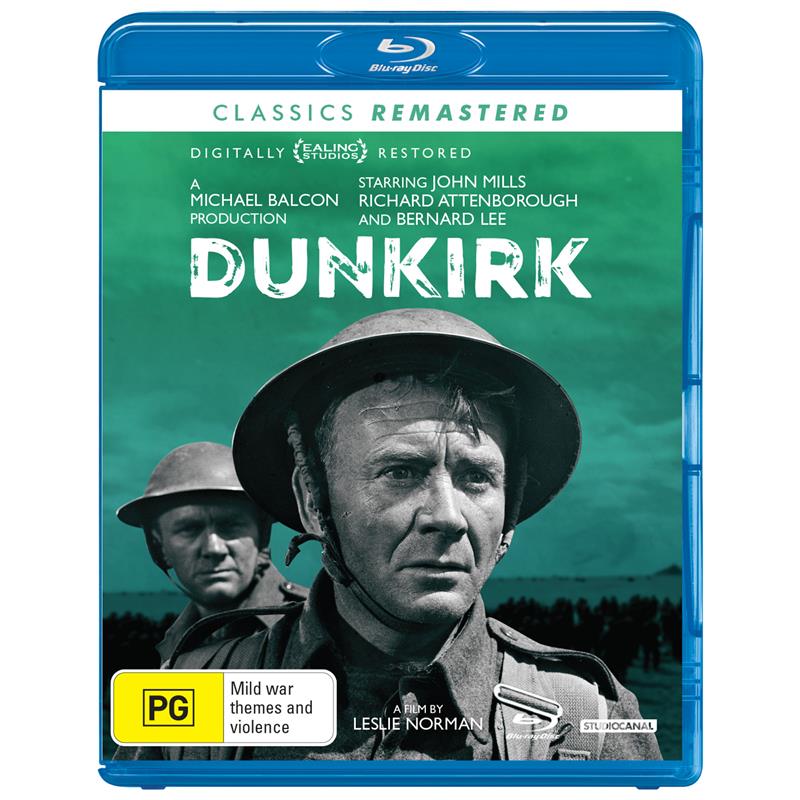Dunkirk (1958) (Blu-ray) |
|
Dunkirk (1958) (Blu-ray) |
|


|
| BUY IT |
| General | Extras | ||
| Category | War |
Interviews-Cast-Actor Sean Barrett (22:17) More…-Dunkirk Operation Dynamo Newsreel (3:53) Short Film-Young Veteran (22:23) More…-John Mills Home Movie Footage (9:59) Gallery-Photo-Behind the Scenes |
|
| Rating |

|
||
| Year Of Production | 1958 | ||
| Running Time | 135:39 | ||
| RSDL / Flipper | Dual Layered | Cast & Crew | |
| Start Up | Menu | ||
| Region Coding | 2,4 | Directed By | Leslie Norman |
|
Studio
Distributor |
Ealing Studios Sony Pictures Home Entertain |
Starring |
John Mills Richard Attenborough Bernard Lee Sean Barrett Robert Urquhart Ronald Hines |
| Case | Standard Blu-ray | ||
| RPI | ? | Music | Malcolm Arnold |
| Video | Audio | ||
| Pan & Scan/Full Frame | None |
English DTS HD Master Audio 2.0 mono German DTS HD Master Audio 2.0 mono |
|
| Widescreen Aspect Ratio | 1.66:1 | ||
| 16x9 Enhancement |
 |
||
| Video Format | 1080p | ||
| Original Aspect Ratio | 1.66:1 | Miscellaneous | |
| Jacket Pictures | No | ||
| Subtitles |
English for the Hearing Impaired German |
Smoking | Yes |
| Annoying Product Placement | No | ||
| Action In or After Credits | No | ||
When the German army rolled across Belgium and France in May 1940, the remnants of the BEF (British Expeditionary Force) together with French and Belgian soldiers were trapped around the harbour and beaches of Dunkirk. Although attacked from the air by the Luftwaffe, in Operation Dynamo over 330,000 men were rescued by the Royal navy and a flotilla of small boats in what came to be called the “miracle of Dunkirk”. Christopher Nolan’s 2017 film Dunkirk depicted these events; however, another film of that name was made in black and white by Ealing fifty years ago in 1958, less than twenty years after the actual events. The two films are very different, and I am not just talking about the technical improvements in filmmaking since 1958; they show how much filmmaking has changed since 1958. For while Nolan drops us right into the chaos of Dunkirk without any explanation or character introductions, the 1958 film directed by Leslie Norman (who has The Shiralee (1957) among his credits), takes its time to set up the situation and the main characters, reserving the scenes on the beaches until about 90 minutes into the film.
Until then the 1958 Dunkirk introduces the main characters: newspaper reporter and small boat owner Charles Foreman (Bernard Lee), machine shop proprietor and small boat owner John Holden (Richard Attenborough) and his young worker Frankie (Sean Barrett). However the principal character during the first section of the film is Corporal “Tubby” Binns (John Mills) of the BEF who, with a small squad of soldiers including Mike (Robert Urquhart) and Miles (Ronald Hines), is cut off by the rapid German advance and have to cross France, fighting and / or evading German forces, until they end up at Dunkirk. There the two sections of the story intersect as both Foreman and Holden are among those who take their small boats across the Channel to rescue the stranded soldiers.
Filmed on the Comber Sands in England with the cooperation of the army who provided troops to the production, at a time before CGI the scenes along the open beach, with men trapped in the dunes awaiting rescue or wading into the sea to be picked up, or not, by small boats, all the time shelled and bombed by the Germans with a burning town in the background, are simply astounding. Of course, the constraints of budget and the technical limitations in 1958 limit what is on screen; the boats sinking are obvious models (very quaint), while German aircraft are limited to stock footage of Stukas diving. In sequences on the beaches, the Dunkirk mole, the dive bombing of a BEF artillery battery or the strafing of a refugee column, we are shown the explosions but not the aircraft. Indeed, unlike Nolan’s film, which juxtaposed air, land and sea sequences, there is no air element and the Royal navy is a presence. However, and again unlike the 2017 film, this allows this 1958 film to concentrate upon the characters trapped along the beach, the death of one principal character a tragic, and dramatic, moment.
During his long career John Mills played a large number of military characters, although he won his only Oscar for a very different type of role in Ryan’s Daughter (1970). In Dunkirk he is in his element as a common, but determined and resourceful soldier. Bernard Lee is best remembered these days for his role as “M” in numerous Bond films and it is great to see him in an earlier, meaty role. The most complex performance however comes from Richard Attenborough as the boat owner with a wife and young child who becomes a most reluctant warrior.
Whereas Nolan’s film never strays from the area around Dunkirk, this 1958 Dunkirk shows scenes in army HQ and Naval command, broadening the scope of the picture. It also finds time to add some awkward moralising dialogue scenes about the cause and effects of war that seem out of place, but were pretty standard in war films of the period. The result is very different from Nolan’s take on the battle. However, Dunkirk is a product of the time it was made and remains a well-acted, spectacular and well put together film within the technical limitations of the time.
Dunkirk is presented in the original 1.66:1 aspect ratio, in 1080p, using the MPEG-4 AVC code.
This is a print of a 50 year old black and white film. The Blu-ray cover notes that the film has been digitally restored and indeed the sequences shot for the film have strong detail, very good blacks and grey scale and only a few minor marks. Whites, brightness and contrast are consistent. The sections where the film uses stock footage of German aircraft, contemporary newsreels of people or tanks rolling are much softer and do have a range of artefacts including scratches, grain and marks but these sequences are not frequent.
A choice of English subtitles for the hearing impaired or German subtitles is provided.
| Sharpness | |
| Shadow Detail | |
| Colour | |
| Grain/Pixelization | |
| Film-To-Video Artefacts | |
| Film Artefacts | |
| Overall |
Audio is a choice of English or German DTS-HD MA 2.0 mono; the film was shown theatrically with mono sound.
Dialogue is always easy to understand. While this is a mono audio the effects such as the explosions, cannon fire and aircraft engines have some depth; indeed, the explosions of the bombs on the sand amongst the soldiers, or the impacts on the boats, reverberate nicely. The score by Malcolm Arnold, who that year won an Oscar for The Bridge on the River Kwai, is dramatic, and especially effective over the scenes of the small boat flotilla setting out for France.
There is obviously no surround or subwoofer use.
I did not notice any hiss or distortion.
Lip synchronisation was fine.
| Dialogue | |
| Audio Sync | |
| Clicks/Pops/Dropouts | |
| Surround Channel Use | |
| Subwoofer | |
| Overall |
As a 17 year old Barrett played Frankie on the small boat beside Richard Attenborough. He is a pleasant and engaging speaker and in this recent interview he talks about his career, director Leslie Norman, the scale of the production, cast members Attenborough and Bernard Lee as well as providing a number of amusing anecdotes about the shoot.
A fascinating contemporary Pathe newsreel, complete with scratches and marks.
A short propaganda film released, I would guess, in late 1940 using newsreel footage from 1939 and 1940. It covers the last days of peace, the Norwegian campaign, France and Dunkirk, the Battle of Britain and the recruiting and training of the new army that will defeat Hitler. Fabulous stuff!
Mills shot colour 16 mm footage on the set of Dunkirk. Silent, with marks but interesting.
Twenty-two on set stills; silent, use the remote to advance to the next still.
NOTE: To view non-R4 releases, your equipment needs to be multi-zone compatible and usually also NTSC compatible.
This release of Dunkirk is identical to the Region B UK release. There is currently no US version.
Made in 1958 Dunkirk is a product of its times in its filmmaking techniques and the gradual development of the story until the climax in the last third of the film. Even without the advantage of CGI it is a sweeping spectacle with a good cast of interesting characters we care about, stiff upper lips, bumbling and chaos. There is no blood or shattered limbs of course, but filmed less than 20 years after the events it shows there were still many veterans still alive who were there so the film looks and feels authentic; black and white always seems more real in this type of war pictures!
The film looks good on Blu-ray, the audio is the original mono. The extras, especially the wartime newsreel and short film, are fascinating.
| Video | |
| Audio | |
| Extras | |
| Plot | |
| Overall |
| Review Equipment | |
| DVD | Sony BDP-S580, using HDMI output |
| Display | LG 55inch HD LCD. This display device has not been calibrated. This display device is 16x9 capable. This display device has a maximum native resolution of 1080p. |
| Audio Decoder | NAD T737. This audio decoder/receiver has not been calibrated. |
| Amplification | NAD T737 |
| Speakers | Studio Acoustics 5.1 |